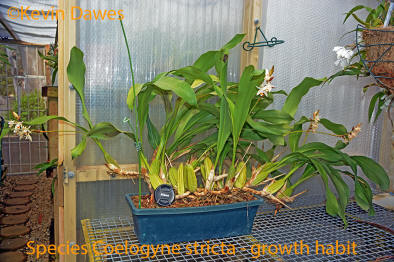The small to medium size flowers of Coelogyne stricta are so pristine white and the orange markings so contrasting that it screams attention. It is tough and very easy to grow and flower. It originates in the Himalayas at altitudes to 2000 metres. However, I don't recommend any orchid be exposed to frost (or direct sun) unless you want a tatty unattractive plant. Most plants in nature are a poor imitation of their cultivated and spoilt cousins!
Cultivation Suggestions: This orchid needs a lot of space and some special potting. It produces big, fat, highly glossy rhizome growths that think of nothing else but getting out of their pot. I have tamed mine a little by using a long window-sill trough and planting at one end, pointing towards the other end. Big side shoots are eventually chopped off and planted in the same pot but facing the opposite direction. By pruning the growths and strategically planting them back in the pot, a reasonably compact plant will result.
Another frequently recommended method is to use a very large mount. This does not appeal to me because mounts need a lot more watering to keep moisture levels high and it does not solve the problem of big lateral growths trying to make the plant look out of control.
Negatives: It is very difficult to keep this orchid in its container for long. Also, there is a lot of vegetation for the amount of flower and this species only flowers once a year. If not regularly divided the pot can become very space greedy and easily exceed over a metre in width - see image above!
Rating: ♦♦♦ The pretty flowers make this a very worthy orchid if you have lots of space and time to manage it carefully.
Varieties: None known but it is very similar to the slightly more refined Coelogyne calcicola.
Hybrids:
1. Coelogyne Andrew Banks - (David Banks 2015) using Coelogyne mooreana as the pollen parent.
| < Coel speciosa | Coel swaniana > |
